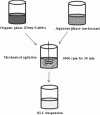Nanostructured lipid carriers: a potential drug carrier for cancer chemotherapy
- PMID: 23167765
- PMCID: PMC3561225
- DOI: 10.1186/1476-511X-11-159
Nanostructured lipid carriers: a potential drug carrier for cancer chemotherapy
Abstract
Nanotechnology having developed exponentially, the aim has been on therapeutic undertaking, particularly for cancerous disease chemotherapy. Nanostructured lipid carriers have attracted expanding scientific and commercial vigilance in the last couple of years as alternate carriers for the pharmaceutical consignment, particularly anticancer pharmaceuticals. Shortcomings often came across with anticancer mixtures, such as poor solubility, normal tissue toxicity, poor specificity and steadiness, as well as the high incidence rate of pharmaceutical resistance and the rapid degradation, need of large-scale output procedures, a fast release of the pharmaceutical from its carrier scheme, steadiness troubles, the residues of the organic solvents utilized in the output method and the toxicity from the polymer with esteem to the carrier scheme are anticipated to be overcome through use of the Nanostructured Lipid Carrier. In this review the benefits, types, drug release modulations, steadiness and output techniques of NLCs are discussed. In supplement, the function of NLC in cancer chemotherapy is presented and hotspots in research are emphasized. It is foreseen that, in the beside future, nanostructured lipid carriers will be further advanced to consign cytotoxic anticancer compounds in a more efficient, exact and protected manner.
Figures




References
-
- Gregoriadis G, Florence AT, Patel HM. In: Drug Targeting and Delivery. Florence AT, Chur GG, editor. Harwood Academic Publishers GmbH; 1993. Liposomes in drug delivery.
Publication types
MeSH terms
Substances
LinkOut - more resources
Full Text Sources
Other Literature Sources

